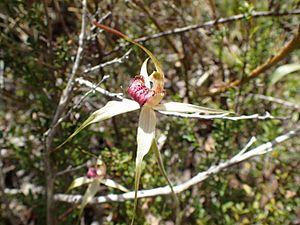Robust spider orchid facts for kids
Quick facts for kids Robust spider orchid |
|
|---|---|
 |
|
| Caladenia valida growing near Victor Harbour | |
| Scientific classification | |
| Genus: |
Caladenia
|
| Species: |
valida
|
| Synonyms | |
|
Caladenia reticulata var. valida Nicholls |
|
The robust spider orchid (Caladenia valida) is a special type of orchid that grows only in south-eastern Australia. It's called a "ground orchid" because it grows from the ground, not on trees. This beautiful plant has a single, slightly hairy leaf and usually one to three white or cream-colored flowers. Sometimes, these flowers even have cool red stripes! It looks a bit like another orchid called Caladenia reticulata, but the robust spider orchid is bigger and taller.
Contents
About the Robust Spider Orchid
The robust spider orchid is a perennial plant, which means it lives for more than two years. It's also a deciduous herb, so its leaves might fall off in some seasons. This orchid has a hidden underground tuber, which is like a small storage root. From this tuber grows a single leaf, about 10 to 15 centimeters long and 1 to 2.5 centimeters wide. This leaf has a few hairs and often has red spots near its base.
What Its Flowers Look Like
The robust spider orchid usually has one, two, or three flowers. These flowers can be up to 7 centimeters wide and grow on a hairy stem that stands 20 to 40 centimeters tall. The flowers have special parts called sepals and petals. The sepals have dark red, club-shaped tips that are about 3 to 5 millimeters long.
The top sepal, called the dorsal sepal, stands upright or curves forward. It's about 3.5 to 5 centimeters long. The two side sepals curve downwards and are also about 3.5 to 5 centimeters long. The petals are similar in size, about 3.5 to 4.5 centimeters long, and they also curve downwards.
The most interesting part is the labellum, which is like the orchid's "lip." It's cream-colored to white with red markings. The sides of the labellum have small, reddish teeth, and its tip curves downwards. Along the middle of the labellum, there are four to six rows of reddish bumps called calli. These calli are tiny, about 1 millimeter long. You can see these beautiful flowers blooming in September and October.
How It's Different from Other Orchids
The robust spider orchid looks a lot like Caladenia reticulata. In fact, it was once thought to be just a type of Caladenia reticulata. However, the robust spider orchid is generally larger and taller. Its sepals and petals spread out more stiffly.
A cool difference is how they are pollinated! Caladenia reticulata is pollinated by a specific type of wasp called Phymatothynnus victor. But the robust spider orchid (Caladenia valida) is pollinated by a different wasp, Phymatothynnus pygidialis. This shows how unique each orchid species can be!
How It Got Its Name
This orchid was first officially described in 1942 by a person named William Henry Nicholls. He first called it Caladenia reticulata var. valida. The first plant he studied was found near Portland. Later, in 1989, two other botanists, Mark Clements and David Jones, decided it was special enough to be its own species. They then gave it the name Caladenia valida.
The word valida comes from Latin and means "strong" or "powerful." We don't know exactly why Nicholls chose this name, but it certainly fits a robust orchid!
Where Does It Live?
The robust spider orchid grows in two states in Australia: Victoria and South Australia. It likes to live in areas near the coast, often in a type of plant community called heathland. In Victoria, you can find it near towns like Portland and Anglesea. In South Australia, it grows on Kangaroo Island and the southern part of the Fleurieu Peninsula.
Protecting the Robust Spider Orchid
Sadly, the robust spider orchid is an "endangered" plant. This means there aren't many of them left, and they are at risk of disappearing forever. Because of this, it is protected by special laws. In Victoria, it's listed as endangered under the Flora and Fauna Guarantee Act 1988. In South Australia, it's protected under the National Parks and Wildlife Act 1972. These laws help to protect the orchid and its habitat, so future generations can still see this amazing plant.

